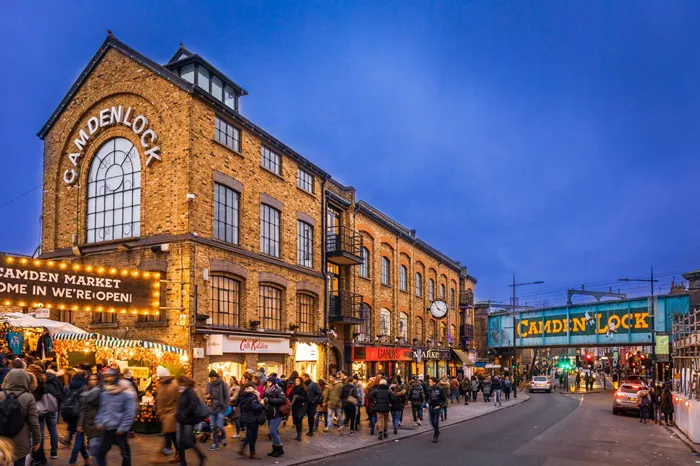Camden, a vibrant district located in North London, is renowned for its unique blend of cultural diversity, historical charm, and modern-day creativity. Whether you’re drawn by its eclectic markets, live music venues, or the picturesque Regent’s Canal, Camden offers something for everyone. Here’s a deeper look at the many facets that make Camden famous.
Camden Market
Camden Market is one of the largest and most diverse markets in London, attracting millions of visitors each year. The market is a maze of stalls and shops, each offering a variety of goods. Notable sections of the market include Camden Lock Market, Stables Market, and Inverness Street Market, each with its own distinct character. Camden Lock Market is known for its handmade crafts and alternative fashion, while Stables Market is a hub for vintage clothing, antiques, and quirky items. Inverness Street Market offers a mix of fresh produce, street food, and unique goods. Camden Market is also famous for its international food stalls, serving everything from Ethiopian cuisine to gourmet burgers, making it a food lover’s paradise.
Live Music Scene
Camden’s live music scene has long been a focal point of London’s musical culture. The area has been home to some of the most iconic music venues in the city, including Koko, the Underworld, and the Electric Ballroom. Koko, a former theatre turned music venue, has hosted performances from a variety of famous artists, including Prince, the Arctic Monkeys, and Amy Winehouse. The Underworld is known for its intimate setting and focus on rock and metal bands, while the Electric Ballroom is a larger venue that regularly features both emerging talent and established acts. Camden has played a pivotal role in the careers of many musicians and continues to be a major draw for both music lovers and aspiring artists.
Cultural Diversity
One of Camden’s defining features is its cultural diversity. The area attracts people from all walks of life, creating a melting pot of different backgrounds and traditions. Camden has long been associated with alternative fashion and counterculture, and its streets are lined with independent boutiques and vintage clothing shops. The area is also known for its street art, with murals and graffiti decorating many of its walls, adding to its vibrant and eclectic atmosphere. Camden’s international influence is also evident in its dining options, with a wide range of eateries offering food from all over the world. Whether you’re in the mood for Asian street food, Mediterranean delicacies, or traditional British fare, Camden offers an abundance of choices.
Historical Significance
Camden’s history dates back to the 1790s when it was first developed as a residential area. The district saw significant growth in the 19th century with the arrival of the Grand Union Canal, which transformed Camden into a bustling commercial hub. The canal played a vital role in the transportation of goods, and many of the area’s warehouses were converted into shops, markets, and residential spaces. Over the years, Camden has evolved into a thriving cultural hotspot, yet it still retains much of its historical charm, with beautiful Georgian architecture and canalside views offering a glimpse into the area’s past.
Regent’s Canal
One of the most scenic aspects of Camden is the Regent’s Canal, which runs through the district and provides picturesque spots for leisurely strolls, boat rides, and tranquil moments away from the bustling market areas. The canal was originally constructed as a means of transporting goods, but today it serves as a peaceful retreat in the heart of the city. Visitors can enjoy canal-side cafés, take boat tours, or simply walk along the towpath to explore Camden’s unique blend of nature and urban life. The canal is also an important part of Camden’s history, contributing to the district’s growth as a commercial and residential area.
Famous Residents
Camden has been home to a number of notable individuals, adding to its rich cultural heritage. Famous residents include the poet Dylan Thomas, who lived in Camden in the 1940s, and the renowned artist Walter Sickert, known for his connections to the Camden Town Group of painters. Perhaps most famously, Camden was the home of the late singer Amy Winehouse, whose legacy continues to resonate with the area’s artistic and musical spirit. Amy’s connection to Camden is celebrated by her fans, and her memory is an integral part of the district’s cultural identity.
Shopping and Dining
Beyond the iconic market stalls, Camden offers a wide range of shopping and dining options. The area is home to numerous independent boutiques, vintage stores, and alternative fashion shops, making it a popular destination for those seeking unique clothing and accessories. Camden is also famous for its food scene, with an abundance of international eateries offering everything from mouth-watering street food to sit-down dining experiences.
The markets themselves are teeming with food stalls that serve dishes from around the globe, and nearby restaurants offer everything from vegan cuisine to traditional British pub fare.
Conclusion
Camden is a truly unique destination that offers a mix of culture, history, and modern creativity. Whether you’re exploring the markets, enjoying live music, or strolling along Regent’s Canal, Camden’s eclectic charm is sure to leave a lasting impression. Its vibrant atmosphere, diverse culture, and rich history make it one of London’s most beloved districts, attracting visitors from all over the world.
Related topics:
- What Food Is New York City Famous For?
- What is Kingston upon Thames Famous For
- What Is the Tower of London Most Famous For

